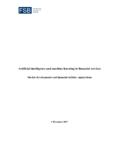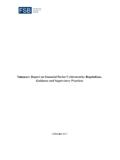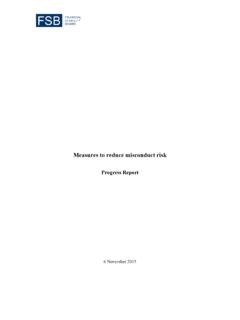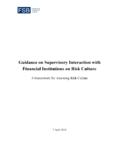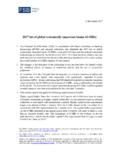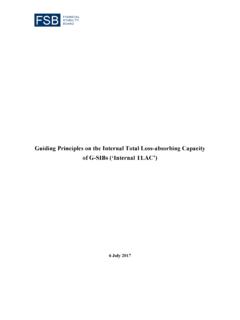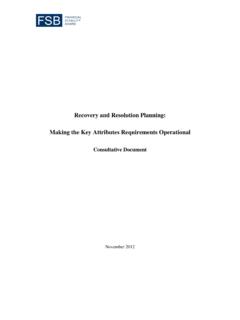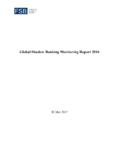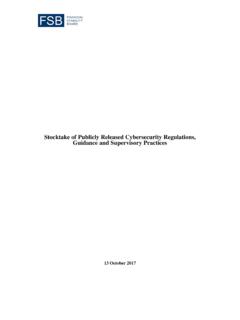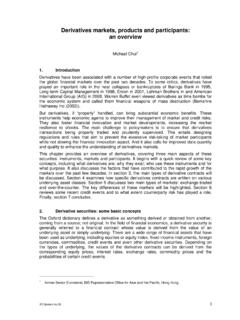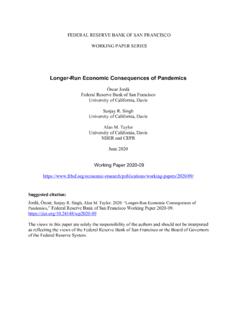Transcription of Enhancing the Resilience of Non-Bank Financial ...
1 Enhancing the Resilience of Non-Bank Financial Intermediation Progress report 1 November 2021 The Financial Stability Board (FSB) coordinates at the international level the work of national Financial authorities and international standard-setting bodies in order to develop and promote the implementation of effective regulatory, supervisory and other Financial sector policies. Its mandate is set out in the FSB Charter, which governs the policymaking and related activities of the FSB. These activities, including any decisions reached in their context, shall not be binding or give rise to any legal rights or obligations. Contact the Financial Stability Board Sign up for e-mail alerts: Follow the FSB on Twitter: @FinStbBoard E-mail the FSB at: Copyright 2021 Financial Stability Board.
2 Please refer to the terms and conditions iii Table of Contents Executive summary .. 1 1. Introduction .. 4 2. A framework for Enhancing NBFI Resilience .. 5 The NBFI ecosystem .. 7 The need for liquidity and its availability in stress .. 9 Liquidity imbalances and the NBFI work programme .. 11 3. Work progress in assessing and addressing vulnerabilities in specific areas .. 12 Enhancing money market fund (MMF) Resilience .. 12 Liquidity risk and its management in OEFs .. 13 Margining practices .. 15 Liquidity, structure and Resilience of core bond markets .. 17 USD funding and external vulnerabilities in emerging market economies .. 19 4. Towards a systemic approach to NBFI.
3 20 Enhancing understanding of systemic risk in NBFI .. 20 Developing policies to enhance NBFI Resilience .. 22 5. Way forward .. 24 iv 1 Executive summary This report describes progress over the past year and planned work by the FSB, as well as by standard-setting bodies (SSBs) and other international organisations, to enhance the Resilience of Non-Bank Financial intermediation (NBFI). NBFI has grown considerably over the past decade to almost half of global Financial assets and become more diverse. As a result, the importance of NBFI for the real economy has increased and is likely to continue to grow. The March 2020 turmoil has underscored the need to strengthen Resilience in the NBFI sector.
4 Some parts of the Financial system, particularly banks and Financial market infrastructures, were able to absorb rather than amplify the macroeconomic shock, supported by the post-crisis reforms. However, key funding markets experienced acute stress and public authorities needed to take a wide range of measures to support the supply of credit to the real economy. Enhancing NBFI Resilience is intended to ensure a more stable provision of financing to the economy and reduce the need for extraordinary central bank interventions. Building on the lessons from the March 2020 market turmoil, the FSB s NBFI work programme includes analytical and policy work to examine and, where appropriate, address specific issues that contributed to amplification of the shock; Enhancing understanding and strengthening the monitoring of systemic risks in NBFI; and assessing policies to address systemic risks in NBFI.
5 The more prominent role of debt markets and NBFI has made funding and market liquidity more central to the capacity of the NBFI sector, and the Financial system at large, to absorb shocks of different types. Large shifts in the demand for, and supply of, liquidity may result in liquidity imbalances, for instance as market participants seek to increase cash holdings while at the same time liquidity supply may decline due to deleveraging and reduction of market making services. If such imbalances become sufficiently pervasive, deteriorating liquidity conditions may create risks to Financial stability. Changes to the Financial system over the past decade have resulted in shifts to both the demand and supply of liquidity, as well as changes to their sensitivity to a given shock.
6 On the one hand, the demand for liquidity has increased as the size of debt markets and the importance of investors offering liquidity on demand have grown. This growth may have been sustained by the low interest rate environment and other factors that have encouraged debt accumulation and a search for yield by investors. On the other hand, the supply of market liquidity by banks which continue to play a critical role in core funding markets has not kept pace with this increase. Market developments that reduced the risk-adjusted return of intermediation, post-crisis regulatory reforms to increase bank Resilience (which proved successful during the pandemic), and broader changes in business models may have contributed to this outcome.
7 Moreover, while new players have diversified liquidity provision in some markets in recent years, they have only limited incentives to intermediate in stress. The combination of these factors implies potentially larger swings in liquidity needs for a shock of a given size. In addition, greater interconnectedness among market participants has accentuated liquidity imbalances transmitted through different parts of the system. The availability of liquidity and its effective intermediation under stressed market conditions is a key determinant of the functioning and Resilience of the NBFI ecosystem. Efficient and resilient market-based intermediation depends on the ability of market participants to manage risks 2 efficiently and minimise market dislocations when adjusting their portfolios.
8 These dislocations become more likely in the case of large imbalances between liquidity supply and demand. NBFI Resilience therefore depends on the behaviour of different types of entities in the NBFI ecosystem as well as on the infrastructure and activities that connect those entities together, and with other parts of the Financial system. The main focus of work to date has been on assessing and addressing vulnerabilities in specific areas that may have contributed to the build-up of liquidity imbalances and their amplification. This includes policy work to enhance MMF Resilience ; work to assess liquidity risk and its management in open-ended funds (OEFs); work to examine the structure and drivers of liquidity in core bond markets during stress; an examination of the frameworks and dynamics of margin calls in centrally cleared and non-centrally cleared derivatives and securities markets; and an assessment of the fragilities in USD cross-border funding and their interaction with vulnerabilities in emerging market economies (EMEs).
9 Building on the findings in the first part, the second part of the FSB s work programme aims to develop a systemic approach to NBFI. It involves Enhancing the understanding of systemic risks in NBFI to strengthen their ongoing monitoring; and, where appropriate, developing policies to address such risks, including by assessing the adequacy of current policy tools given the desired level of Resilience for the sector. Efforts to develop a systemic approach to NBFI can build on existing work. The work in specific areas under the NBFI work programme to date has helped to deepen the understanding of vulnerabilities in particular NBFI activities and entities, including their implications for system-wide liquidity risk conditions.
10 Many of these vulnerabilities had already been identified in previous work, and frameworks and tools have been developed by securities markets regulators to address them. However, Enhancing the understanding of systemic risk in NBFI and developing policies to address such risk needs to take explicit account of the lessons from the March 2020 turmoil, including the increased importance of assessing interconnections. Understanding systemic risks in NBFI involves analysis of the interaction and propagation of risks from a system-wide perspective. Conceptually, such a system-wide perspective would combine: (i) an assessment of potential vulnerabilities and the resulting liquidity demands under stress across different Non-Bank Financial institutions and markets; (ii) the identification and quantification of the main interconnections that propagate liquidity imbalances across the global Financial system; and (iii) an assessment of the potential interaction of vulnerabilities and interconnections, and their implications for the liquidity of core markets that underpin the functioning of the global Financial system.
